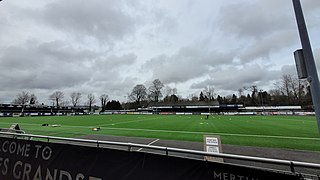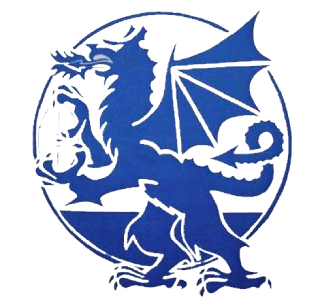Related Research Articles

Pontypridd, colloquially referred to as Ponty, is a town and a community in Rhondda Cynon Taf, South Wales, approximately 10 miles north west of Cardiff city centre.

The Wales national rugby league team represents Wales in representative rugby league football matches. Currently the team is ranked 17th in the IRL World Rankings. The team was run under the auspices of the Rugby Football League, but an independent body, Wales Rugby League, now runs the team from Cardiff. Six Welsh players have been entered into the Rugby Football League Hall of Fame.
Rugby league is a sport played in Wales. The governing body of the game in Wales is the Wales Rugby League.

Penydarren Park is a sports stadium in Merthyr Tydfil, Wales, that is the present home ground of Merthyr Town Historically used for varying sports, it has been the home to two professional football teams, Merthyr Town and Merthyr Tydfil F.C.
Kingsley Jones is a Welsh rugby union coach, currently in charge of the Canadian national team. A former Welsh international player, Jones has played and coached at various levels, from playing at the amateur level to the professional level in Wales and England. He since went on to become a professional coach at club and international level.
William Isaac C. Stott was an English professional rugby league footballer who played in the 1930s and 1940s. He played at representative level for England and Yorkshire, and at club level for Featherstone Rovers, Broughton Rangers, Oldham, Wakefield Trinity (captain) and Belle Vue Rangers, as a goal-kicking centre or stand-off.
Pontypridd F.C. is an amateur Welsh football team based in Pontypridd, formed in 2018 and inspired by the former professional club Pontypridd AFC that existed between 1911 and 1926. The club was reformed in May 2018 by former members of the Pontypridd Town reserve team. and play in the TERV Division One.

James Arthur Bacon was a Welsh rugby union, and professional rugby league footballer who played in the 1910s, 1920s and 1930s, and coached rugby league in the 1920s. He played club level rugby union (RU) for Cross Keys, and representative level rugby league (RL) for Great Britain, Wales and Monmouthshire, and at club level for Leeds (captain), and Castleford, as a wing, or centre, and coached at club level for Castleford.

Cardiff City Blue Dragons were a rugby league team formed in 1981. Their home ground was initially Ninian Park, which was also used by Cardiff City F.C. The club spent three seasons in Cardiff before relocating to Bridgend in 1984 as the Bridgend Blue Dragons, and were finally wound up in 1986. The team colours were royal blue shirts with a yellow and white vee. The shorts and socks were also blue.
Melville "Mel" Aaron Rosser sometimes recorded as Melvin and Melvyn was a Welsh international rugby centre who played rugby union for Penarth and Cardiff and later turned to professional rugby league joining first Leeds, then Castleford, and then York. Rosser played international rugby for Wales under both union and league codes, and toured Australia with the Great Britain rugby league team in 1928.
William Rhodes was a Welsh professional rugby league footballer who played in the 1920s. He played at representative level for Wales, and at club level for Pontypridd and Warrington, as a wing or centre.
George Oliver was a Welsh dual-code international rugby union and professional rugby league footballer who played in the 1910s and 1920s. He played representative level rugby union (RU) for Wales, and at club level for Talywain RFC, Pill Harriers RFC and Pontypool RFC, as a lock, and representative level rugby league (RL) for Wales and Monmouthshire, and at club level for Hull FC and Pontypridd, as a prop or hooker.
Emlyn Watkins was a Welsh dual-code international rugby union and professional rugby league footballer who played in the 1920s. He played representative level rugby union (RU) for Wales, and at club level for Blaina RFC, as a flanker, and representative level rugby league (RL) for Wales and Monmouthshire, and at club level for Leeds and Oldham RLFC, as a second-row.
Brinley "Bryn" Phillips was a Welsh dual-code international rugby union and professional rugby league footballer who played in the 1920s. He played representative level rugby union (RU) for Wales, and at club level for Taibach RFC, Aberavon RFC and Glamorgan Police RFC, as a lock, and representative level rugby league (RL) for Wales and Glamorgan, and at club level for Huddersfield, as a second-row or loose forward.

Frederick "Fred" Leonard Roffey was an English rugby union and professional rugby league footballer who played in the 1910s and 1920s. He played club level rugby union (RU) for Ebbw Vale RFC, and representative level rugby league (RL) for Wales and Monmouthshire, and at club level for Wigan and St. Helens (captain), as a prop, hooker, second-row, or loose forward.
Sydney Hinam was a Welsh rugby union and professional rugby league footballer who played in the 1920s. He played representative level rugby union (RU) for Wales, and at club level for Cardiff RFC and Glamorgan Police RFC, as a flanker, and representative level rugby league (RL) for Glamorgan, and at club level for Rochdale Hornets, as a prop.
William P. James was a Welsh rugby union and professional rugby league footballer who played in the 1920s. He played representative level rugby union (RU) for Wales, and at club level for Llanelli RFC, as a wing, and representative level rugby league (RL) for Glamorgan, and at club level for Leeds, as a wing.
South Wales RLFC was a rugby league club formed in 1995. South Wales during their existence played at Morfa Stadium, Swansea, the Talbot Athletic Ground, Aberavon and Cardiff Arms Park.
Taff Vale Park is a rugby union ground and former greyhound racing track in Treforest, Pontypridd, Rhondda Cynon Taf, Wales.

Welsh handball is one of the ancient native sports of Wales. It is related to coeval sports such as Irish handball, fives, and Basque pelota and is a possible antecedent of American handball. The sport has been continually attested since the Middle Ages and its popularity saw it become an important expression of Welsh culture, offering ordinary people opportunities through prize money, bookkeeping and even player professionalism.
References
- ↑ Wigan Fans 1926-27 season
- ↑ Daryl Leeworthy (2013). ‘The Dragons of the North: Working-Class Culture, the Miners' Lockout, and the Development of Rugby League in South Wales, 1926–31’. In ‘’Sport in History’’, vol. 33, issue 1, 2013. Available at http://www.tandfonline.com/doi/full/10.1080/17460263.2013.763284#abstract.
- ↑ Daryl Leeworthy (2013). ‘The Dragons of the North: Working-Class Culture, the Miners' Lockout, and the Development of Rugby League in South Wales, 1926–31’. In ‘’Sport in History’’, vol. 33, issue 1, 2013. Available at http://www.tandfonline.com/doi/full/10.1080/17460263.2013.763284#abstract.
- ↑ Daryl Leeworthy (2013). ‘The Dragons of the North: Working-Class Culture, the Miners' Lockout, and the Development of Rugby League in South Wales, 1926–31’. In ‘’Sport in History’’, vol. 33, issue 1, 2013. Available at http://www.tandfonline.com/doi/full/10.1080/17460263.2013.763284#abstract.
- ↑ Daryl Leeworthy (2013). ‘The Dragons of the North: Working-Class Culture, the Miners' Lockout, and the Development of Rugby League in South Wales, 1926–31’. In ‘’Sport in History’’, vol. 33, issue 1, 2013. Available at http://www.tandfonline.com/doi/full/10.1080/17460263.2013.763284#abstract.
- ↑ Irvin Saxton (publish date tbc) "History of Rugby League – № 32 – 1926–27". Rugby Leaguer ISBN n/a
- ↑ Daryl Leeworthy (2013). ‘The Dragons of the North: Working-Class Culture, the Miners' Lockout, and the Development of Rugby League in South Wales, 1926–31’. In ‘’Sport in History’’, vol. 33, issue 1, 2013. Available at http://www.tandfonline.com/doi/full/10.1080/17460263.2013.763284#abstract.